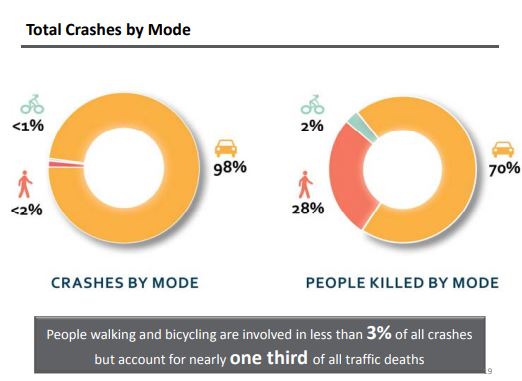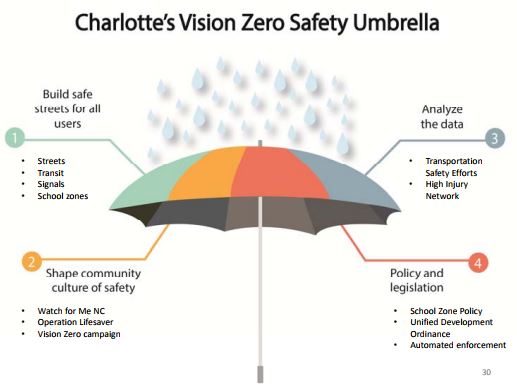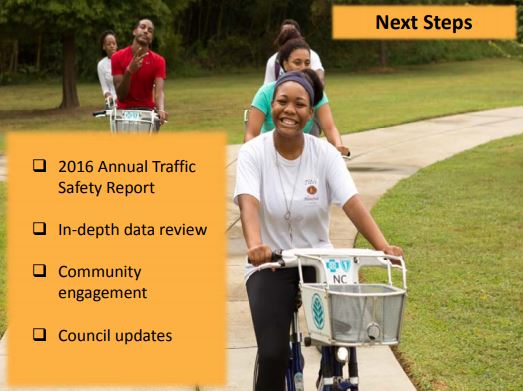Charlotte’s road to Vision Zero
Pedestrians and cyclists account for less than 3% of Charlotte’s street users, but account for almost 30% of traffic fatalities.

Pedestrians and cyclists are the most vulnerable users of streets. (image: CDOT)
View the full presentation that the City Council’s Transportation & Planning Focus Area committee saw at their September 25 meeting. We first shared a summary of Charlotte’s approach to Vision Zero back in May. Since then, the Charlotte Department of Transportation (CDOT) staff have been working to refine the goals and strategies of the Vision Zero initiative.
When City Council approved the Transportation Action Plan earlier this year, they embraced Objective 2.5.1: “The City will implement a Vision Zero initiative by developing a comprehensive program for partnerships, engineering, education, community outreach, and possible speed and red light running enforcement.”
Vision Zero began in Sweden, where traffic deaths are down 30% as a result. It’s a policy declaring that no traffic fatality or serious injury is acceptable. Human error is inevitable, but the consequences should not be fatal.
CDOT is using the model of an umbrella to conceptualize their approach:

CDOT’s Vision Zero Safety Umbrella includes multiple approaches. (image: CDOT)
Let’s take a peek under the umbrella.
1. Build safe streets for all users. This includes four major sub-categories: streets, transit, signals, and school zones. It’s all about adding and improving infrastructure like sidewalks, safer intersections, pedestrian refuge islands, new traffic signals and crossing beacons, school zone signage, flashers on thoroughfares, and more.
2. Shape community culture of safety. Watch For Me NC, Operation Lifesaver, and CDOT’s new Vision Zero campaign aim to educate all streets users on the importance of doing their part to stay safe. CDOT hosts drop-in meetings as well as pop-up meetings to bring educational opportunities to residents close to their homes. They also lead participatory walking tours with residents as part of their corridor studies.
3. Analyze the data. Last year there were 53 fatal crashes on Charlotte’s non-interstate streets. That’s 53 too many.
CDOT’s Traffic Safety Program Manager Angela Berry shared that Charlotte’s total annual crashes have increased significantly since 2012, despite little change in total vehicle miles traveled. This same trend is being seen across the country. Driver inattention/distraction has been recognized as a contributing circumstance in about 28% of Charlotte’s crashes, but the actual number is probably considerably higher than is reported. Nearly 25% of crashes relate to speeding or failure to reduce speed.
4. Policy and legislation. CDOT has identified three opportunities including improved school zone policy, coordinating with the creation of the new Unified Development Ordinance (UDO), and automated enforcement. Charlotte needs to better align its zoning and approach to land development with the city’s transportation goals. If our community values safe walkability and bikeability, we need a development ordinance that supports those aspirations!
There are currently no speed cameras or red light cameras in Charlotte due to challenging state legislation and funding requirements. But when CDOT analyzed 17 intersections that had red light cameras in 2001, the results were compelling: Angle crashes (typically caused by a vehicle running a red light and hitting another vehicle on its side) decreased by an incredible 60%. That’s significant because angle crashes often result in serious injury or death. Although rear-end crashes increased by 4%, that type of crash is usually less likely to result in injury.
What’s next?

(Image: CDOT)
CDOT’s 2016 Annual Traffic Safety Report should be published any day now. Staff will continue to analyze data and engage the community in efforts to improve street safety, with a focus on networks of streets that have a higher incidence of severe and fatal crashes.
We’re encouraged that CDOT is thinking about and working towards Vision Zero with a holistic approach. But there’s a long road ahead. It’s clear that the current rate of investment in infrastructure and enforcement isn’t going far enough to stem the rising tide of serious traffic injuries and fatalities, so we continue to remind our elected officials of the need to accelerate the building of safer streets and invest in efforts to support safe behavior.
We’ll keep you posted! Join us at an upcoming City Council Transportation and Planning meeting!
Thanks for reading!
As a nonprofit, community support is essential for us to keep doing what we do — including providing free articles like this. If you found this article helpful, please consider supporting Sustain Charlotte.
Want to stay in the loop? Subscribe to our weekly newsletter and follow us on Instagram, Facebook, and Twitter.
